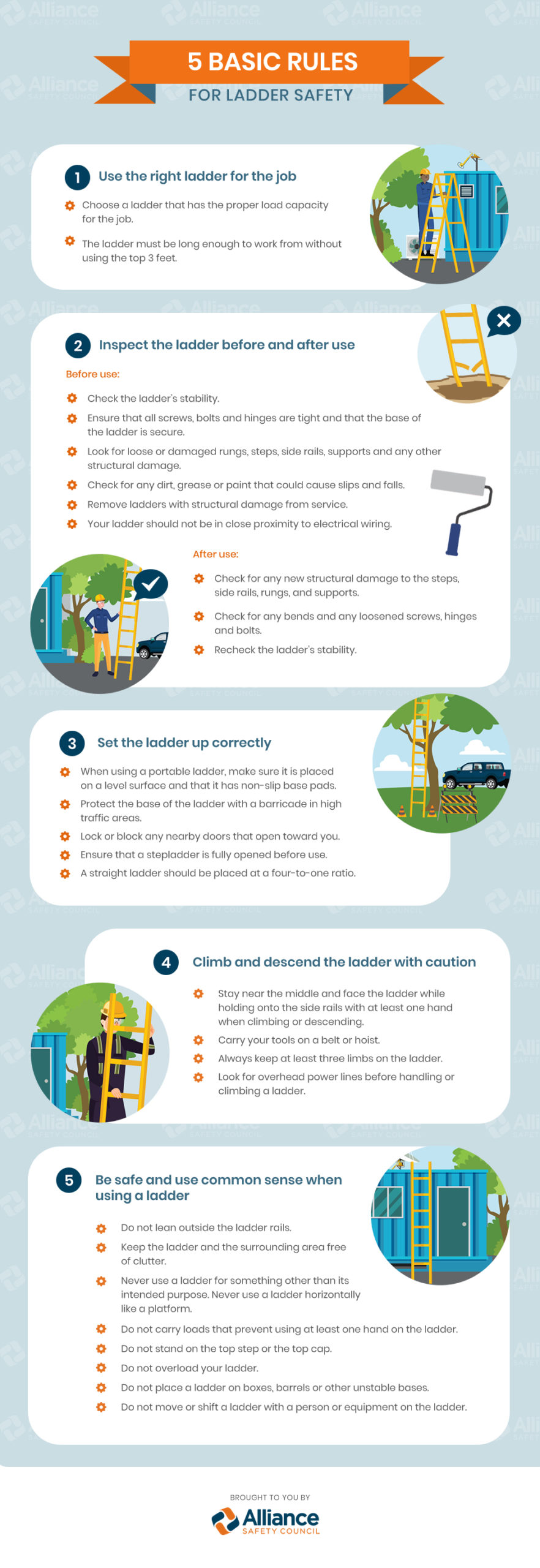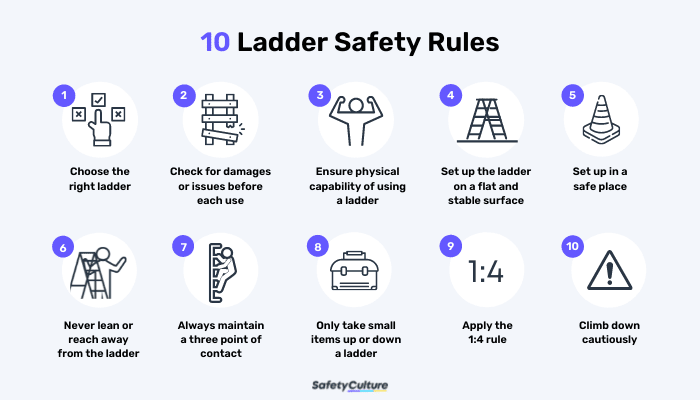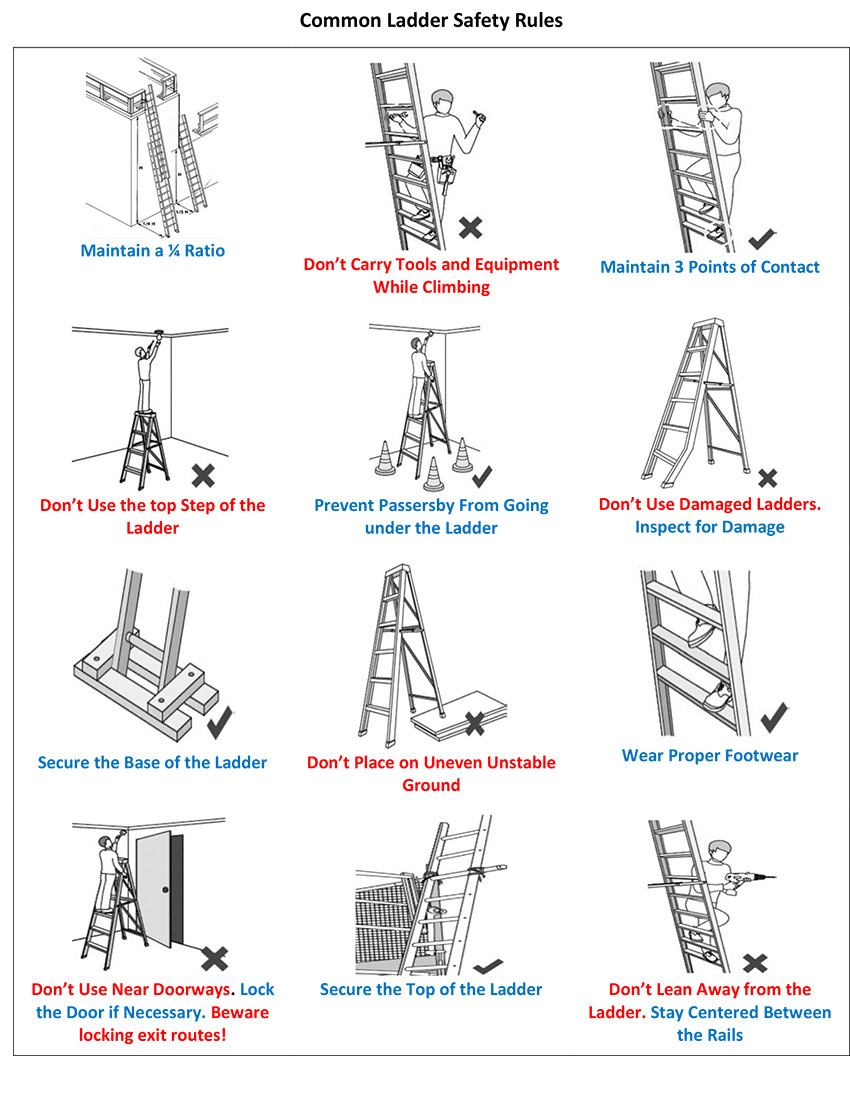The basic rule for ladder use is to always maintain three points of contact. This means having both feet and one hand or both hands and one foot on the ladder at all times.
Ladders are essential tools used in various settings, from construction sites to homes. However, improper use can lead to accidents and injuries. Understanding and following the basic rule of maintaining three points of contact while climbing or descending a ladder is crucial for safety.
By adhering to this rule, individuals can significantly reduce the risk of falls and ensure a secure and stable climbing experience. Proper ladder use is not only important for personal safety but also for maximizing efficiency and productivity in any task that requires working at heights.

Credit: alliancesafetycouncil.org
Importance Of Ladder Safety
Ladder safety is of utmost importance, and understanding the basic rules for ladder use is crucial. By following these guidelines, you can ensure a safe and accident-free experience while working on a ladder.
Workplace Hazards
When it comes to ladder use in the workplace, it is crucial to be aware of the potential hazards that can arise. Understanding these hazards is the first step towards ensuring ladder safety and preventing accidents or injuries. Some common workplace hazards that can make ladder use dangerous include:
- Poorly maintained or damaged ladders
- Unstable or uneven surfaces
- Lack of proper training or supervision
- Overreaching or leaning to the side while on a ladder
- Carrying heavy or bulky items while climbing
By addressing these hazards in the workplace, employers can create a safer environment for their employees and reduce the risk of ladder-related incidents.
Legal Compliance
Ensuring legal compliance is essential when it comes to ladder safety. Employers have a responsibility to follow the relevant laws and regulations to minimize the risk of accidents and protect the well-being of their workforce.
The Occupational Safety and Health Administration (OSHA) provides guidelines and regulations for ladder use in different industries. These guidelines specify the proper use, inspection, and maintenance of ladders, as well as training requirements for employees. By adhering to these regulations, employers can demonstrate their commitment to workplace safety.
Additionally, employers should regularly assess their ladder equipment, ensuring it meets safety standards and is free from defects. Proper record-keeping of inspections, maintenance, and training can also serve as valuable evidence of compliance in the event of an incident.
In conclusion, by understanding workplace hazards and adhering to legal compliance, employers can establish a safe ladder use environment. Implementing these measures not only safeguards employees but also contributes to a positive safety culture within the organization. Prioritizing ladder safety is crucial in ensuring the well-being of the workforce and reducing the risk of accidents or injuries.

Credit: safetyculture.com
Selecting The Right Ladder
When it comes to ladder safety, selecting the right ladder is crucial to prevent accidents and ensure efficiency. Assessment of Task and understanding the Types of Ladders available are key steps in choosing the appropriate ladder.
Assessment Of Task
- Determine the height you need to reach.
- Evaluate the weight the ladder will need to support.
Types Of Ladders
There are various types of ladders designed for specific tasks:
- Step Ladder: Suitable for tasks that require reaching moderate heights.
- Extension Ladder: Ideal for tasks that involve accessing higher areas like rooftops.
Considering the task at hand and the height required will help you choose the appropriate ladder for safe and effective use.
Setting Up The Ladder
When setting up a ladder, it is crucial to follow the basic rules to ensure safety and proper functionality. One of the key aspects in ladder use is properly setting up the ladder to prevent accidents and injuries. This involves surface inspection, positioning, and angle adjustment to maintain stability and security.
Surface Inspection
Before placing the ladder, inspect the ground to ensure it is level and stable. Remove any debris or obstacles that may cause the ladder to wobble or slip. Check for slippery surfaces or uneven terrain that could compromise the ladder’s stability.
Positioning And Angle
Position the ladder at the correct distance from the work area to avoid overreaching or leaning. The ideal angle for a ladder is about 75 degrees. Ensure the ladder’s feet are securely planted and there is no gap between the ladder and the surface it rests on.

Credit: ghba.org
Basic Rules For Ladder Use
Using a ladder might seem simple at first, but it’s important to follow some basic rules to ensure your safety. By adhering to these guidelines, you can minimize the risk of accidents and injuries. In this section, we will discuss three essential rules that you must keep in mind when using a ladder: Three-Point Contact, Weight Limit, and Proper Placement.
Three-point Contact:
When using a ladder, maintaining three-point contact is crucial for stability and balance. Three-point contact means that at least three of your four limbs (hands and feet) are in contact with the ladder at all times. This ensures that you have a secure grip and reduces the chances of slipping or falling.
To maintain three-point contact:
- Keep both feet securely on the ladder rungs.
- Use both hands to grip the ladder or hold onto the side rails.
- Avoid leaning too far to either side, as it can cause the ladder to tip over.
Weight Limit:
Every ladder comes with a specific weight limit that you must adhere to. Exceeding this weight limit can compromise the ladder’s structural integrity and increase the risk of accidents. Before using a ladder, ensure that you check the weight limit indicated by the manufacturer.
When using a ladder:
- Take your body weight and any additional weight from tools or materials into consideration.
- Never exceed the weight limit specified by the ladder manufacturer.
- If you need to carry heavy loads, consider using a ladder with a higher weight capacity or find alternative methods for transporting the items.
Proper Placement:
Where you place your ladder also plays a significant role in your safety. Incorrect ladder placement can lead to instability and accidents. To ensure proper placement:
- Select a flat and stable surface for your ladder.
- Avoid placing the ladder on slippery or uneven surfaces.
- If possible, secure the ladder with the help of a ladder stabilizer or by tying it down to a solid structure.
Remember, safety should always be your top priority when using a ladder. By following the basic rules of ladder use, you can minimize the chances of accidents and ensure a safe working environment.
Climbing And Descending Safely
When using a ladder, proper climbing and descending techniques are essential for safety. It’s crucial to adhere to safe techniques and cautionary measures to minimize the risk of accidents.
Safe Techniques
When climbing a ladder, ensure that it is secured and stable. Maintain three points of contact at all times, such as two hands and one foot or two feet and one hand. Ascend and descend facing the ladder while keeping your body centered between the side rails and not overreaching.
Cautionary Measures
- Inspect the ladder for any damage or defects before use.
- Use non-slip footwear to prevent any potential slips or falls.
- Do not carry heavy or bulky items while climbing up or down the ladder.
- Avoid leaning or reaching out from the ladder, as it can cause imbalance and lead to accidents.
Maintenance And Inspection
Proper ladder use involves maintaining equipment, performing routine inspections, and following safety guidelines. Always check for defects before each use and never exceed the ladder’s weight capacity. It is essential to secure the ladder properly and avoid using it on uneven or slippery surfaces.
Maintenance and inspection are crucial aspects of ladder safety. Regular checks, repairs and replacements are vital for ensuring the integrity and stability of ladders. These tasks help to identify any issues or wear and tear that could compromise the safety of the ladder. Regular Checks Regular checks involve inspecting the ladder before each use. Ensure there are no loose or missing bolts, cracks, bends, or split rungs. Also, ensure the ladder feet are not worn and the locking mechanisms are in good condition. Repairs and Replacements If any issues are found during the regular checks, prompt repairs and replacements are necessary. Any damaged or worn components should be replaced, and repairs should be conducted by a professional if needed. Regular maintenance and prompt repairs contribute to the safety and longevity of ladders. By adhering to these basic rules, accidents and injuries can be prevented, ensuring a safe working environment.Frequently Asked Questions Of What Is The Basic Rule For Ladder Use
What Are The Basic Rules For Ladder Use?
The basic rules for ladder use include checking for defects before use, placing on a stable surface, and maintaining three points of contact while climbing.
Why Is It Important To Follow Ladder Safety Guidelines?
Following ladder safety guidelines is crucial to prevent accidents, falls, and injuries while working at heights. It ensures a safe and efficient work environment.
How Can I Ensure Proper Ladder Positioning?
To ensure proper ladder positioning, place it on a level surface, secure the base, and use the correct angle – approximately 75 degrees – between the ladder and the ground.
Conclusion
Understanding and following the basic rules for ladder use is paramount for ensuring safety and preventing accidents. By using the ladder correctly, maintaining three points of contact, securing the ladder properly, and being aware of the weight and position limits, you can decrease the risk of falls and injuries.
Remember to always inspect the ladder before each use and seek professional guidance if needed. Prioritizing safety when using ladders is essential for everyone’s well-being. Stay safe!
{ “@context”: “https://schema.org”, “@type”: “FAQPage”, “mainEntity”: [ { “@type”: “Question”, “name”: “What are the basic rules for ladder use?”, “acceptedAnswer”: { “@type”: “Answer”, “text”: “The basic rules for ladder use include checking for defects before use, placing on a stable surface, and maintaining three points of contact while climbing.” } } , { “@type”: “Question”, “name”: “Why is it important to follow ladder safety guidelines?”, “acceptedAnswer”: { “@type”: “Answer”, “text”: “Following ladder safety guidelines is crucial to prevent accidents, falls, and injuries while working at heights. It ensures a safe and efficient work environment.” } } , { “@type”: “Question”, “name”: “How can I ensure proper ladder positioning?”, “acceptedAnswer”: { “@type”: “Answer”, “text”: “To ensure proper ladder positioning, place it on a level surface, secure the base, and use the correct angle – approximately 75 degrees – between the ladder and the ground.” } } ] }
